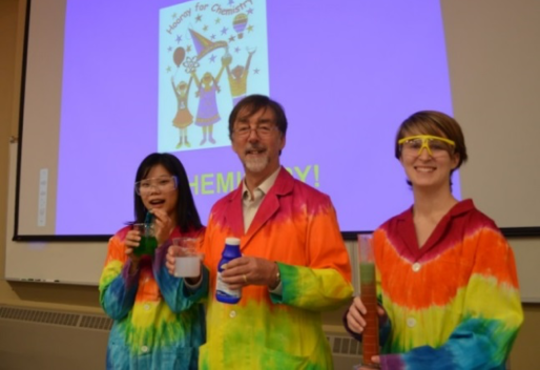In August 2015, Educational Innovations was able to bring back goldenrod paper. For years, this paper had been discontinued, apparently because goldenrod paper was not able to be recycled. The fibers in the paper were saturated with golden colored dye. In the process of turning the paper back into a pulpy mixture, the golden dye would color all the other paper pulp that was also being recycled. Think of it as the bright red shirt in a washing machine filled with whites. This problem with golden dye was why chemistry teachers loved this paper. The golden-yellow paper turns a deep red when it comes in contact with a base such as washing soda or Windex®. The process was reversed if an acid such as vinegar was sprayed on the paper.
For several years, knowing that it would be impossible to find, and also knowing that teachers around the world loved this paper, Educational Innovations bought up as much as could feasibly fit in our warehouse. Some five years later, we had finally run out, and had not been able to find a supplier for it. So while we looked for a source and since it is still referenced in many science journals, we decided that teachers might be interested in making their own goldenrod paper. So now you can make it yourself or buy it at Educational Innovations.
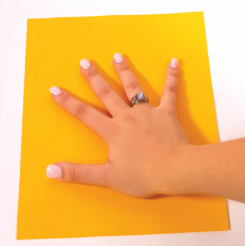
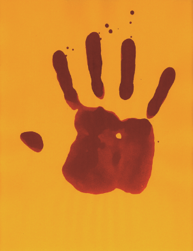
To make color-changing paper similar to goldenrod paper use household turmeric powder. Although turmeric is insoluble in water, in a workshop at Sacred Heart University, ca 1987, we discovered it was soluble in either ammonia or ethyl alcohol. White paper dipped in a solution of ammonia with dissolved turmeric will be dyed red, which turns to yellow as the paper dries; dipped in a solution of turmeric and alcohol, the paper will remain yellow as it dries. When dry, test and observe how similar and how different the paper is from the color-changing goldenrod. Note: although this paper seems to react similar to color-changing goldenrod, the color fades much faster.
How to make goldenrod paper
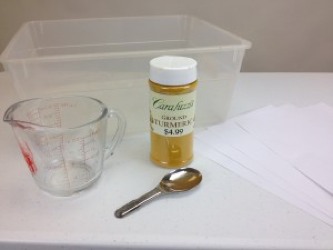 Ingredients
Ingredients
- Turmeric
- Distilled water
Boil water. Add four tablespoons of turmeric for every two cups of water.
Turmeric is a bright golden colored spice used in many Asian dishes and is available at most grocery stores. Stir the turmeric into the water until the water turns a bright yellow.
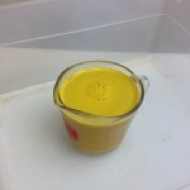 Pour the turmeric solution into a plastic tub and then soak your regular white paper in the solution. Be careful not to get the solution on your clothing, nails or skin unless you like yellow stains…
Pour the turmeric solution into a plastic tub and then soak your regular white paper in the solution. Be careful not to get the solution on your clothing, nails or skin unless you like yellow stains…
Remove the paper from the turmeric solution and lay it on a clean paper towel. As it dries, excess turmeric powder begins to flake. To remove the excess turmeric, tap the dry paper over the tub or use a soft paper towel to wipe off the excess turmeric.
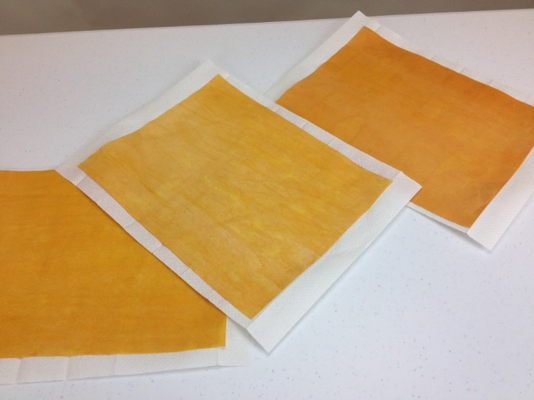
Activities
You are now ready to conduct your acid-base chemistry activities!
Ron Perkins posted simple activities with goldenrod paper.
- Write a “secret” message on the paper with paraffin or candle wax. The invisible message can be seen by spraying or wiping the paper with a weak basic solution e.g., ammonia or baking soda. If you use ammonia solution, the message will disappear when the ammonia evaporates. If you use a baking soda solution, the message will remain.
- Write a message on the paper using a cotton swab dipped into household ammonia. As the ammonia evaporates, the red message disappears.
- Repeat Activity #2 using a cotton swab dipped into a solution of baking or washing soda. The message can be erased using vinegar as “Yellowout”.
- Use goldenrod paper to classify household products as acidic or basic. Solutions that turn yellow paper red are bases; solutions that turn red paper yellow are acids; and solutions that do not turn the color of either paper are considered “neutral”.
- Tape a piece of yellow goldenrod paper to the board. Dip your hand into a shallow container of baking or washing soda and water. Then, when you press your hand against the paper, you will leave a “bloody” hand-print — especially useful at Halloween. Idea compliments of Bob Becker in 1985 (Kirkwood School District, Kirkwood, Missouri).
- Sponge the surface of a piece of goldenrod paper with a baking soda or washing soda solution and allow the wet, bright red paper to dry. Then, tape the paper to the board and press a hand that has been dipped into vinegar against the paper. The yellow hand-print will be the reverse or the “negative” of the result in activity #5. Idea compliments of Carl Ahlers (Australia) in 2008.
More advanced activities with goldenrod paper
7. Sponge a solution of baking soda or washing soda on a piece of goldenrod paper. Observe that the red color becomes gradually darker. Explain.
Carl Ahlers has written:
“Drying shifts the equilibrium in reaction 1 to the right as the H2CO3 concentration is reduced due to the evolving of CO2 gas (reaction 2,3) (Le Châtelier).”
Subsequently more of the red Gol forms on drying.
HGol + HCO31-(aq) ⇋ Gol1- + H2CO3(aq) Reaction 1
yellow red
H2CO3(aq) ⇋ CO2(aq) + H2O Reaction 2
CO2(aq) → CO2(g) Reaction 3
8. Determine the equilibrium constant, the Ka, for this acid/base indicator. One way is to prepare a set of different pH solutions using a method of serial dilution on a spot plate or in small test tubes. Then, test to see at what pH the color change seems to occur.
9. Prepare acid/base color changing paper using natural indicators: rose petals, purple cabbage, etc. Then determine the pKa of those papers.
Note: Currently, paper of the same color, Galaxy Gold, is being offered by retail office supply stores; however, this paper uses a different dye and is not color changing.
This article is a combination of three blog posts at the Educational Innovations website.



